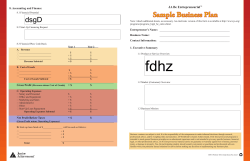
How to valuate a Social Enterprise? NTI University/ Business School Nederland
How to valuate a Social Enterprise? NTI University/ Business School Nederland Angelique Smit Student number: 972326822 Address: Ponyweide 70, 2727 HM Zoetermeer, the Netherlands #189-191, Street 600r, Toul Kork, Phnom Penh, Cambodia Summary: How to Value a Social Enterprise? Executive Summary The search for the value of a social enterprise has been rocky, bumpy, disappointing and rewarding. Valuation of social companies is clearly a trending topic because my field research has received large worldwide attention from international social entrepreneurs, investors, universities and interested individuals. For two weeks in a row my topic was ‘most discussed’ topic in two separate online LinkedIn groups and was rated ‘most interesting’ in four groups. A social enterprise is different from a commercial enterprise because the first one has as primary goal ‘creating social value’ while the second one has a focus on ‘creating money value’ (profit maximisation). The social entrepreneur knows that to be successful a balance between social and financial value creation is important (also called the double/triple bottom line). Investors in social enterprises need to understand that when profit maximisation is not the focus of the social entrepreneur, it also should not be the focus of the investor. It is my belief that profit maximisation is going to be an obsolete word but still this research started with the word ‘value’, which is seen as the equivalent of ‘money’. Monetising financial results is relatively easy and straightforward but monetising social impact has been proven difficult, but still this is what people expect when the word ‘value’ is used. The reason for doing a valuation is the first question that needs to be answered by the (social) entrepreneur. Is it to value social or environmental impact? Or the financial returns or for knowing the market value of an organisation? Valuation of social enterprises is a novel subject and with this research I want to bring the discussion to the next level with as ultimate goal a better balance between social and financial aspects and that they are both represented in the total company value. Only when social value can be brought into the standard financial valuation methods and thereby showing the economic benefit to investors or buyers, social value creation will gain more interest. Legal regulation will hugely help this process. Through the discussions and interviews in this research some food for thought has come up for new discussions. The three most interesting ideas are listed below but they need much more discussion in a wider community: Angelique Smit 2012 info@ideas-at-work.org 1 Enterprise? Social Enterprise? Value aa Social to Value How to Summary: How Summary: a. risk reduction of social enterprise is greater than of a commercial company. b. discount rates could be valued differently in social companies maybe even zero percent. c. social credits used in a similar way as carbon credits are currently used. In chapter 5 this is further discussed and explained. The research question for this dissertation was: How to valuate a social enterprise? and that cannot be answered in one reply. 1. There is no silver bullet for valuing a social enterprise. A single methodology that has been widely adopted throughout the social and financial sector that includes social value in the total financial value of an organisation is a myth; at least for now. 2. The current valuation systems are kept in place by the financial world and because their interest is solely on economical value creation, therefore this is what is been calculated. Putting financial value on any organisation is relatively easy when there are financial figures available and a (business) plan for the future. Although even in calculating financial values, different people come up with different values even if they started with the same figures. No rules of thumb exist for social enterprises’ market value calculations as they do for most type of branches where commercial companies work. It seems with the current focus on money and monetising everything some would say ’social value has no value’. Not everything can be monetised ánd should be monetised. Trying to put a money value on a beautiful sunset is subjective and subjective value is very difficult to measure, if not in many cases impossible. 3. It doesn’t mean that social organisations that not (yet) make a profit have no value. As long as valuation and monetisation is used in one line, the financial valuation methods of a social enterprise are not different than for a commercial enterprise. If market value is what you are after than it is set by what an interested purchaser or investor is willing to pay. However most purchasers and investors do not put value on social impact. Still this research indicates that a well prepared social entrepreneur might be able to negotiate up to 5% extra of total company value when he/she argues the social and financial value convincingly and with evidence. Angelique Smit 2012 info@ideas-at-work.org 2 Summary: How to Value a Social Enterprise? 4. Social value leads to social impact but might take a long time to become visible. Many inputs from different groups can have an effect on the actual outcome. The Social Return on Investment (SROI) model is the only model that monetises impact results. Nonetheless it does not add up in one number for social and financial value. It also does not have a place on the balance sheet or the profit/loss statements of an organisation. It only describes a ratio of the value that stakeholders of an activity or organisation experience to the total investment done. However I do believe that the road towards measuring this impact value is more valuable than the actual $/₤/€-amount outcome. The real value of the SROI model is in the process of identifying and measuring outcomes that supported the organisation’s mission and activities. It is a difficult exercise and without high quality data, any results will be based on one assumption after another. If the social sector is interested in creating more precise, meaningful approaches to measuring and/or estimating social value, foundations, investors and governments will need to invest in increasing the quality. 5. Measuring impact is good. The question is if impact measurement is the responsibility of the (social) entrepreneur or the person that requests this information. Any entrepreneur should do what he/she is good at and what is good for the company. Collecting data to understand the successes or the failures is at the heart of every business. Social companies should add information that is verifying if their social goals are being reached. While a management information system is giving internal performance, social value indicators could give external feedback on received services or products. Positive social impact does not (yet) have influence on the total company value but a negative social impact will definitely influence the value. 6. Refocusing is needed from the financial valuation of businesses to a blended or shared value system that includes all results created by a company. That includes the double/triple bottom line values such as social, environmental and financial value. Any enterprise needs to have a ‘blended value proposition’ combining revenue generation with social value generating. In that way also the costs that society has of cleaning up after a polluting company leaves will be on that company’s balance sheet. Leading thinkers in this field think it might be two-three decades more before an acceptable system has been developed. Angelique Smit 2012 info@ideas-at-work.org 3 Summary: How to Value Ideas at Work? In addition of the general summary of the research of valuation of social enterprises, Ideas at Work Cambodia was used as an example organisation to apply the findings. This small Cambodian social enterprise manufactures and distributes water pumps to the rural areas of Cambodia and is close to break-even point. The discount cash flow method was advised for financial valuations. The two business valuation web tools used and the excel sheet calculation method of a social investor in Cambodia indicate that the market value of Ideas at Work is currently between US$89,000 and US$133,000. The social impact is clearly more difficult to calculate as was predicted. Both SROI models used for this research give a different ratio. According to both tools Ideas at Work adds social value to their stakeholders of between $1.91 and $3.51 per invested US dollar. The difference between both SROI ratios indicates that IaW should consider external expertise to understand the process and value the real outcome of the process. Only then does the organisation have a chance to convince potential investors of a higher total company value. Adding social value indicators to the monthly management information system will give IaW more awareness on the value they create and give insights on both their social and their financial goals. Used as a business performance indicator it can assist in the direction the business is heading. Angelique Smit 2012 info@ideas-at-work.org 4
© Copyright 2025





















